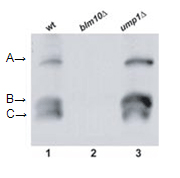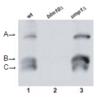Product Details
| Alternative Name: | Blm3, PA200 homolog |
| |
| Host: | Rabbit |
| |
| Immunogen: | Recombinant N-terminal protein fragment (aa 1-157) of Saccharomyces cervisiae Blm10. |
| |
| UniProt ID: | P43583 |
| |
| Species reactivity: | Saccharomyces cerevisiae
|
| |
| Applications: | WB
|
| |
| Recommended Dilutions/Conditions: | Western Blot (1:1,000)
Suggested dilutions/conditions may not be available for all applications.
Optimal conditions must be determined individually for each application. |
| |
| Formulation: | Liquid. Neat serum diluted in PBS containing 0.01% sodium azide. |
| |
| Use/Stability: | Stable for at least 1 year after receipt when stored at -20°C. Dilute with PBS, pH 7.2-7.4, containing 1% normal goat serum (if a goat anti-rabbit IgG linker antibody is to be used). Store diluted antibody at +4°C, do not freeze and use within 1 month. |
| |
| Handling: | Avoid freeze/thaw cycles. After opening, prepare aliquots and store at -20°C. |
| |
| Shipping: | Blue Ice |
| |
| Short Term Storage: | +4°C |
| |
| Long Term Storage: | -20°C |
| |
| Scientific Background: | Blm10 (mammalian homolog PA200) is a large 246kDa regulatory protein that binds to the 20S proteasome core particle (CP). Blm10 recognizes pre-activated open gate CP which is assumed to exist in equilibrium with inactive closed gate CP. Blm10 distinguishes gate conformations, regulates CP activation, and has been shown to be involved in CP maturation. |
| |
| Regulatory Status: | RUO - Research Use Only |
| |

Figure: Western blot detection of Blm10 containing complexes in GFP-labelled CP from wild type (1),
blm10δ (2) and
ump1δ (3) cells using PAb to Blm10 (Prod. No.
BML-PW0570) at 1:1’000 dilution. Key features - A: Blm10-CP-RP, B: Blm10
2-CP, C: Blm10-CP"
Please mouse over
Product Literature References
Yeast PI31 inhibits the proteasome by a direct multisite mechanism: S. Rawson, et al.; Nat. Struct. Mol. Biol.
29, 791 (2022),
Abstract;
Dendritic cells maintain dermal adipose-derived stromal cells in skin fibrosis: J.J. Chia, et al.; J. Clin. Invest.
126, 4331 (2016),
Application(s): Mouse injections treatments,
Abstract;
Full Text
Phosphorylation of the C-terminal tail of proteasome subunit α7 is required for binding of the proteasome quality control factor Ecm29: P. Wani, et al.; Sci. Rep.
6, 27873 (2016),
Application(s): Immunoblotting,
Abstract;
Full Text
Maturation of the proteasome core particle induces an affinity switch that controls regulatory particle association: P.S. Wani, et al.; Nat. Commun.
6, 6384 (2015),
Abstract;
General Literature References
Blm10 binds to pre-activated proteasome core particles with open gate conformation: A. Lehmann, et al.; EMBO Rep.
9, 1237 (2008),
Abstract;
Mobilizing the proteolytic machine: cell biological roles of proteasome activators and inhibitors: M. Rechsteiner & C.P. Hill; Trends Cell Biol.
15, 27 (2005),
Abstract;
Blm3 is part of nascent proteasomes and is involved in a late stage of nuclear proteasome assembly: M. Fehlker, et al.; EMBO Rep.
4, 959 (2003),
Abstract;
Full Text
PA200, a nuclear proteasome activator involved in DNA repair: V. Ustrell, et al.; EMBO J.
21, 3516 (2002),
Abstract;
Full Text












